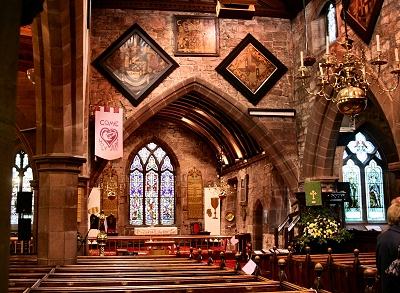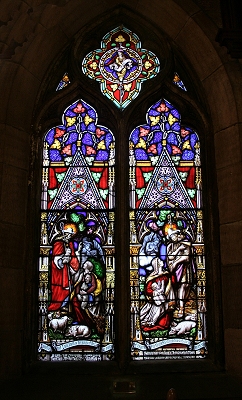|
|
| All Saints Church,
Childwall |
| There was
probably a now demolished chapel on the site of
this beautiful sandstone church in Childwall
Village in the 11th century, and some of the
building materials have Norman or even Saxon
origins. The current name is of relatively recent
origin; a document from the 14th century suggests
that the church was dedicated to St. Peter at
that time. It is Liverpool's oldest parish church
and the only one of mediaeval construction. |
| The
oldest part of the present structure is the north
wall of the chancel with its window, an outer
wall of the tiny original 14th century church,
although the glass in the window is 19th century.
The porch is 15th century and has a Saxon stone
in the west wall, probably a coffin lid, a
ceiling carved with the stone heads of the four
apostles and a 500 year old oak door. The nave,
with its north and south aisles, was added in the
15th century and the sloping floor, which follows
the gradient of the land, once continued into the
chancel before it was levelled in 1851
(regrettably it now seems). |
| The west tower
with its spire was added around the same time as
the nave. Thus the building stood until the early
18th century, when a major programme of extension
and rebuilding began that has continued to the
present day. The tower and spire were demolised
and rebuilt in 1810 following the disaster at St.
Nicholas's church in Liverpool that year, when 25
people died following the collapse of the tower
there. It is thought to have been relocated
slightly further to the west. |
| The churchyard
at All Saints is a profoundly peaceful and
atmospheric place. It was first mentioned in a
document of 1386. One of the oldest epitaphs
reads: 'Sacred to the memory of John Jones, who
departed this life in his 95th year, June 1st,
1517. My sledge and hammer both decline, my
bellows they have lost their wind, my fire is
extinct, my forge decayed, and the dust in my
vice is laid. My coals are spent, my iron is
gone, my nails are driven, my work is done.' |
|
 |
 |
| Window
in the north chancel wall |
|